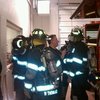School renovation project begins
VOORHEESVILLE The elementary school building has historic charm but also historic parts.
Such as flooring from the 1930s, and a 45-year-old heating system.
The Voorheesville School District is planning a $3 to $4 million renovation project for the school.
One of the greatest expenses is replacing all the unit ventilators, estimated to cost $1 million, and upgrading exhaust and ventilation across the building in corridors, classrooms, and the gymnasium totaling about $670,000 more.
Other elementary-school building renovations include:
Removing asbestos floor tiles and putting in new vinyl composition floor tiles;
Finding a permanent solution to foundation and water leakage at the lower gym;
Replacing existing ceilings and putting in new corridor lighting;
Rehabilitating masonry on the exterior facade and chimney;
Replacing windows with new aluminum windows with insulating glass;
Solving the problem of moisture on the lowest level;
Redesign wheelchair accessibility to the entrance; and
Installing energy-management systems, including digital control of equipment, and low voltage control wiring.
Along with the major improvements to the elementary school, another $1 million worth of renovations are planned for the high school and middle school.
This makes the overall expected project cost for both buildings $4 million to $5 million.
Construction is planned in two main phases, starting in the summer of 2006, with most of the major renovations to be made in the spring and summer of 2007.
A public referendum on the project is expected in April.
The last major building project for Voorhesvilles school district was in 2002, Assistant Superintendent for Business Sarita Winchell said, but only minimal work was done at the elementary school the leach field was abandoned for environmental reasons because it was too close to the stream, and the school was hooked up to a public sewer system.
While the main focus currently is to upgrade the elementary school, a few things were left at the high school which need to be picked up now, Winchell said. Original bathrooms, the tennis court, and 1989 roofing needs to be replaced.
And, at the middle school, locker rooms need to be renovated; new fixtures, tile, ceiling, and partitions are needed, plus some areas of the locker room need to be made accessible to people with physical limitations.
The greatest single expense
Currently, each elementary classroom has its own unit ventilator, Michael Goyer, the director of operations and maintenance, told The Enterprise. The units date back to the early 1980s, he said.
The uni-vents take fresh air from outside and mix it with the heated air inside and then redistributes the combination of air throughout a room, he said. The heated air comes into the rooms through separate piping.
Goyer said that he has a hard time finding parts for the old uni-vents and last winter, with sub-zero temperatures when the power went out, a few of the unit ventilators froze and burst. Unit ventilators are essential for indoor air quality, he said.
Besides the uni-vents, the way that air circulates throughout the building needs to be updated, Goyer said. There is a ventilation system for the building, but that dates back to the 1960s when the addition was put on, he said.
Voorheesvilles old system does not meet the most current specifications for air circulation the building is stuffy, Winchell said.
Upgrades will bring the air exchange up to the current code, Winchell said, so that there is proper exhaust.
Improving the air flow will help with heating costs and also prevent the stifling high temperatures that were recorded in some of the elementary schools second-floor classrooms last spring. It wasnt the outside heat so much but the lack of air flow, Winchell said.
The district has hired an engineering firm to investigate remedies, Goyer said. There isnt piping that circulates air through the building, so it is dependent on natural air flow, where the hallways are and openings are to rooms, he said.
Professional team
The school board hired Integrated Building Systems Engineering Consultants for its mechanical and electrical-engineering services. Kevin Murray is the principal engineer tied to the project.
Integrated Building Systems regularly partners with Dodge, Chamberlin, Luzine, and Weber Associates Architects, which the district also agreed to hire. Michael Fanning is the architect assigned to Voorheesville.
And, the Chazen Companies will be providing the site work and environmental analysis such as the State Environmental Quality Review documentation under the leadership of engineer Joel Bianchi.
The three-company team was proposed by the consulting engineers and approved by the school board at its last meeting.
Murray said they specialize in schools and are familiar with the problems associated with construction at a school. His company brings to the table experience and expertise in technology, electrical work, plumbing and heating, ventilation, air-conditioning analysis and design.
Fanning said 85 percent of the work done by his East Greenbush architectural firm is public school facilities. His firm often works with Integrated Building Systems, the two are practically integrated, collaborating on architectural and engineering design, Fanning said.
Bianchi said he is being brought in for the groundwater issues at the elementary school.
The scope of the over-all project still needs to be worked out.
Superintendent Linda Langevin said that the district’s building committee took representatives from the firms around the school and showed them the "nooks and crannies."
School board member James Coffin, a member of the building committee, said that he likes the idea of using local firms.
Langevin said, while the committee is made up of board members, the building principals, and Goyer, the district still needs to add teachers to the committee as well.
Integrated Building Systems submitted a preliminary proposal report to the school board at the October school board meeting, addressing the basic time line and scope of the project with expected cost.
Prior to a referendum being held, the consultants will be paid $18,600.
A capital reserve fund of $500,000 was established with voter approval after this years April school elections, but that money cannot be spent without approval by the voters.
Winchell said that the $18,600 will come out of the general fund for now, but, once voters hopefully approve the capital-improvement project, the general fund will be reimbursed with money from the reserve fund.
Funding
Voorheesville gets 61.8 percent back in state aid on building projects, Winchell said. The rest is funded through a voter-approved bond issue; 1989s bond issue will be paid off in 2008-09, Winchell said.
Phase one of construction is smaller, and starts in spring of 2006, then runs through that summer. Its a time to expedite projects including replacing the roofing, redoing the high-school tennis courts, and replacing some of the flooring at the elementary school, the engineers report reads.
The report states that these projects can be designed quickly and completed with readily available materials.
Winchell said, if the district can spend under $100,000 on a capital improvement project next year, it will get full aid the following year.
Elementary school
The elementary school, recognized with an historic maker by the side of the road, is comprised of three buildings.
The original building is still the front of the school today, alongside where the buses pull up; the front door dates back to the 1930s, Winchell said. An addition was put on and attached to the right of those front doors in 1949; which blends into the original architecture, Winchell said. The modern back part of the building, seen from Route 85, was added in 1963, Winchell said.
The old section of the school still has original flooring, but now there are "several layers of floor that are cracked and a mess," Winchell said.
The district has waited for years for the state regulations on the removal of asbestos tiles to change and the floors cant wait any longer, Winchell said. The floor is not friable, or easily crumbled, he explained.
The only time the asbestos would become airborne is if someone were to grind down the tile, Goyer said. So In terms of replacing tiles, touching the tiles to remove them there is no danger, Goyer said. But the glue under the tiles is mastic, and there are regulations to remove the tiles and air sampling that has to be done, he said, which the schools maintenance staff is not qualified to do.
The engineers plan says that, in the 1930-40 building, all the existing layers of flooring down to the asbestos tiles can be removed for about $250,000 to $300,000. The new vinyl composition tile will cost $50,000 to $60,000.
A separate major issue at the elementary school is drainage.
The schools gymnasium no longer floods through the door, Winchell said but there are drainage issues.
In the mid-1990s, Voorheesville received a grant from the Federal Emergency Management Agency and a flood wall was erected, paid for by the government; since then, there hasnt been a problem with flooding, but now the concern is groundwater, Winchell said.
In the corner of the small gym where the floor and the wall meet, there is some leaking, she said; it is unclear at this point what is causing that. Also, moisture forms on the basement floor, so the engineers are going to look into how to mitigate that, Winchell said.
When the septic systems went in, part of a storm drain may have been damaged, Winchell said.
The engineering report estimates that solving drainage and leakage at the lower gym could cost anywhere from $250,000 to $450,000. Solving the moisture issue in the lower floor will cost about $140,000. The engineers are considering regrading the existing lawn to slope away from the building and or installing subsurface drainage.
Things are at a real preliminary stage right now, Goyer said.


